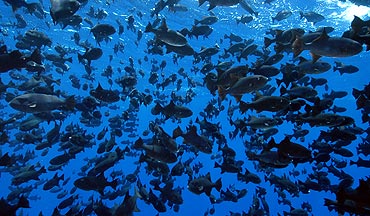Number 136 (September-December 2011)
Editorial
Fish aggregating devices (FADs) are a promising tool for coastal fishers, or could mean destruction of tuna stocks, depending on who you are speaking with. Both perceptions may be right, but they relate to two very different types of FADs: artisanal (small-scale) and industrial.
Artisanal FADs are anchored close to shore to help local fishers gain access to oceanic resources such as tuna, mahi mahi, wahoo and rainbow runner. In doing so, they provide another source of food for families and help fishers move away from declining reef resources.
Industrial FADs are drifting rafts set by purse-seine vessels to concentrate schools of skipjack and mixed tuna species, and to make their operations commercially viable. But, this also means huge catches of unwanted species such as silky sharks and juvenile bigeye tuna, which are already overexploited (see article "2010 overview and status of WCPO tuna stocks"). Artisanal fishers, who use hooks and lines around nearshore FADs, are able to limit their catch to targeted species.
The FAD issue continues to be of interest to many people, and in fact, attracted 150 participants to a conference in Tahiti in November 2011. In the second feature article, a wide panel of experts report on their discussions, their findings, and list research and management needs in this area.
In one of the other feature articles (p. 27), Mark Skinner and his colleagues report on their study of ciguatera poisoning occurrences in the Pacific Islands region. You will probably be as surprised as I was to learn that up to half a million people may have been affected by ciguatera over the last 35 years. The authors suggest that this figure should drive decision-makers to pay much more attention to this issue.
Aymeric Desurmont
Fisheries Information Officer
In this issue
SPC ACTIVITIES
-
2010 overview and status of WCPO tuna stocks (pdf: 388 KB)
-
The effects of ENSO on South Pacific albacore catches (pdf: 59 KB)
-
When economy meets with tuna (pdf: 125 KB)
-
Improving the management of deepwater snapper
resources in Pacific Island countries (pdf: 239 KB) -
Sustainable development and strategic planning
for New Caledonia’s aquarium fishery (pdf: 68 KB) -
Pacific fisheries: Winners and losers identified
in new climate change book (pdf: 234 KB) - Bagan fishing in Majuro, Marshall Islands (pdf: 174 KB)
NEWS FROM IN AND AROUND THE REGION
-
Eat more anchovies (pdf: 122 KB)
-
The 2011 harvest of trochus in Aitutaki, Cook Islands (pdf: 386 KB)
-
DEVFISH II project implementation update (pdf: 87 KB)
-
FFA releases major global tuna industry status report (pdf: 158 KB)
- NFMRA withdraws invitation to Spanish purse-seiners
to fish in Nauru (pdf: 173 KB) - Implementing the full vessel day scheme (pdf: 164 KB)
- Rebuilding fisheries: There’s a smartphone application
for that (pdf: 98 KB)
FEATURE ARTICLES
-
Ciguatera fish poisoning in the Pacific (1998– 2008)
by M. Skinner et al. (pdf: 440 KB) -
Artisanal and industrial FADs: A question of scale
by M. Taquet et al. (pdf: 659 KB) - Investment profile for anchored nearshore FAD
by M. Sharp (pdf: 97 KB)



